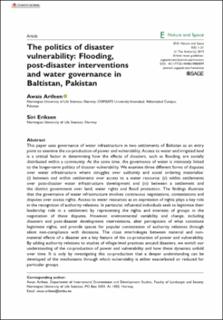| dc.description.abstract | This paper uses governance of water infrastructure in two settlements of Baltistan as an entry point to examine the co-production of power and vulnerability. Access to water and irrigated land is a critical factor in determining how the effects of disasters, such as flooding, are socially distributed within a community. At the same time, the governance of water is intimately linked to the longer-term politics of disaster vulnerability. We examine three different forms of disputes over water infrastructure where struggles over authority and social ordering materialise: (i) between and within settlements over access to a water resource; (ii) within settlements over post-disaster water infrastructure development and (iii) between a settlement and the district government over land, water rights and flood protection. The findings illustrate that the governance of water infrastructure involves continuous negotiations, contestations and disputes over access rights. Access to water resources as an expression of rights plays a key role in the recognition of authority relations. In particular, influential individuals seek to legitimise their leadership role in a settlement by representing the rights and interests of groups in the negotiation of these disputes. However, environmental variability and change, including disasters and post-disaster development interventions, alter perceptions of what constitute legitimate rights, and provide spaces for popular contestation of authority relations through silent non-compliance with decisions. The close interlinkages between material and nonmaterial effects of a disaster are a key feature of the co-production of power and vulnerability. By adding authority relations to studies of village-level practices around disasters, we enrich our understanding of the co-production of power and vulnerability and how these dynamics unfold over time. It is only by investigating this co-production that a deeper understanding can be developed of the mechanisms through which vulnerability is either exacerbated or reduced for particular groups.
Corresponding author: Awais Arifeen, Department of International Environment and Development Studies, Faculty of Landscape and Society, | en_US |
